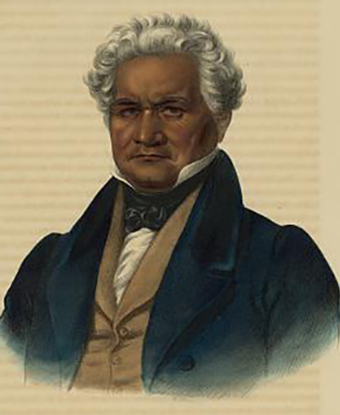Last updated: June 18, 2015
Person
Major Ridge

Library of Congress
Kah-nung-da-tla-geh, (man who walks on the mountaintop) or Major Ridge, was born in 1771 in present-day Tennessee. At the time of Ridge’s childhood, Cherokee society dictated that adolescent boys distinguish themselves in the endeavors of hunting and warfare to become a man. These activities were seen as a rite of passage in Cherokee culture. Ridge did not have to wait too long, and in fact, participated in his first battle at the age of 14. He fought with the Chickamauga Cherokees in their raids on white settlements and distinguished himself as a warrior, and by extension, a man.
Once the Chickamaugas made peace with the American government, Ridge moved his family into present-day Georgia and followed many of the aspects of the government’s “civilization” program, by opening a ferry service and becoming a planter and slaveholder. When the Cherokees created a centralized government, Ridge was selected to serve as a Council member at the age of 21. Ridge and other younger Cherokee leaders stifled the revivalist movement in their Nation that spread in other groups such as the Creeks, Shawnees, and Seneca. When the Red Stick movement resulted in civil war among the Creeks, Ridge was encouraged to pick up the mantle of warrior once again. He, along with other younger members of the Cherokee Council, encouraged their neutral leaning elders to go to war against the Red Stick Creeks as allies of the United States government.
During the Creek War Ridge distinguished himself, and in many ways acted as a good soldier receiving the commission as major. Even so, Ridge continued to act in the role of warrior by taking opportunities for himself on the battlefield rather than waiting for specific orders. An example of such an action is his crossing of the river at Horseshoe Bend. This and the siege with other Cherokee soldiers made General Andrew Jackson’s victory there possible. Ridge, along with many other Cherokee fighters, returned to their homes in the Cherokee Nation with scalps and Red Stick women and children prisoners: the traditional war trophies of successful warriors. Major Ridge kept his commission title, and for the rest of his life he was called Major Ridge. He valued his identity as a United States soldier so much that he wore his military coat when making appearances in public.
Major Ridge embraced both identities of warrior and soldier. His identity as warrior earned him respect among the Cherokees and ultimately a position of leadership within the Nation. Ridge’s identity as a soldier fit best with his desires to be an ally of the United States and adherent of “civilization.” This desire also lead him to sign the 1835 Treaty of New Echota, ceding remaining Cherokee ancestral land for a reservation in Indian Territory. Ultimately, this support would cost him his life. Major Ridge was assassinated in 1839 by oponents to the unpopular treaty.
